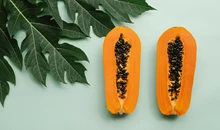
The Punjab Agricultural University (PAU), located in Ludhiana, has shifted its research focus from quantity to quality and from food security to nutritional security.
The institution, known for its pivotal role in the Green Revolution that made India self-sufficient in food grains, has developed a new wheat variety called PBW RS1. This variety contains high levels of amylose starch, which is known to reduce the risk of type-2 diabetes and cardiovascular diseases.
Unlike regular wheat, consuming chapatis made from PBW RS1 does not cause an immediate and rapid rise in glucose levels. The high amylose and resistant starch content in this wheat ensure that glucose is released more slowly into the bloodstream.
Additionally, the slower digestion process increases the feeling of satiety, so a person consuming chapatis made from PBW RS1 would feel full after having just two, compared to four chapatis made from normal wheat.
PBW RS1 has a total starch content similar to other wheat varieties, around 66-70 percent. However, it has a significantly higher resistant starch content of 30.3 percent compared to only 7.5-10 percent in other varieties. It also contains 56.63 percent amylose, while other varieties have only 21-22 percent. These characteristics make PBW RS1 beneficial for promoting a lower glycemic index, reducing the prevalence of diet-related diseases such as obesity and type 2 diabetes.
The development of PBW RS1 took a period of 10 years and involved a team of wheat breeders led by Dr. V S Sohu, the head of the Department of Plant Breeding and Genetics at PAU. The university is the first to combine five novel genes affecting resistant starch levels to develop this variety.
In the past, PAU has released two other wheat varieties, PBW Zn1 with high zinc content and PBW1 Chapati with premium chapati quality, but PBW RS1 stands out due to its unique features.
Achla Sharma, the principal wheat breeder at PAU, acknowledges that millets are considered healthy because they do not cause a spike in blood sugar levels.
However, wheat production and consumption are much higher, and not everyone can incorporate millets into their daily diet. The goal was to breed a wheat variety that provides the taste and feel of normal wheat but with higher resistant starch and a lower glycemic index.
One challenge in cultivating PBW RS1 is its lower productivity compared to other wheat varieties in Punjab. The average grain yield recorded in PAU's field trials was 43.18 quintals per hectare, which is below the state's average yield of 48 quintals.
However, PAU's vice-chancellor, Dr Satbir Singh Gosal, believes that it is essential to begin promoting nutritional security. He suggests that the Punjab government should support the promotion of PBW RS1 flour as a product with high medicinal and nutritional value. With proper marketing, the wheat could command a higher price, similar to the premium paid for basmati paddy over regular varieties.
Dr Gosal proposed that PBW RS1 should be recognized as a special-trait variety that offers high incentives for farmers to grow it, despite the lower productivity. He has pitched the idea of marketing it as a special quality flour to Markfed, the Punjab State Cooperative Supply & Marketing Federation.
According to him, PBW RS1 is the first improved wheat variety in the country bred for quality rather than just quantity.
Seeds of PBW RS1 will be made available to farmers in September, enabling them to sow the wheat in the upcoming rabi season. In addition to its nutritional benefits, PBW RS1 is completely resistant to yellow rust and moderately resistant to brown rust fungal diseases. The taste and texture of chapatis and biscuits made from PBW RS1 flour are comparable to those made from normal wheat.
The increased amylose/resistant starch content, which translates into higher dietary fiber, also benefits bakers and food processors who can produce products without adding fiber or additives from other sources.
Overall, the development of PBW RS1 by PAU represents a significant step towards promoting nutritional security and addressing the prevalence of diet-related diseases in India. By focusing on quality rather than just quantity, the institution is leading the way in developing improved crop varieties that benefit both farmers and consumers.











